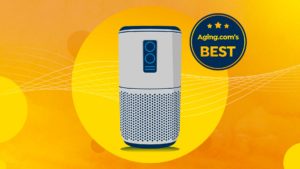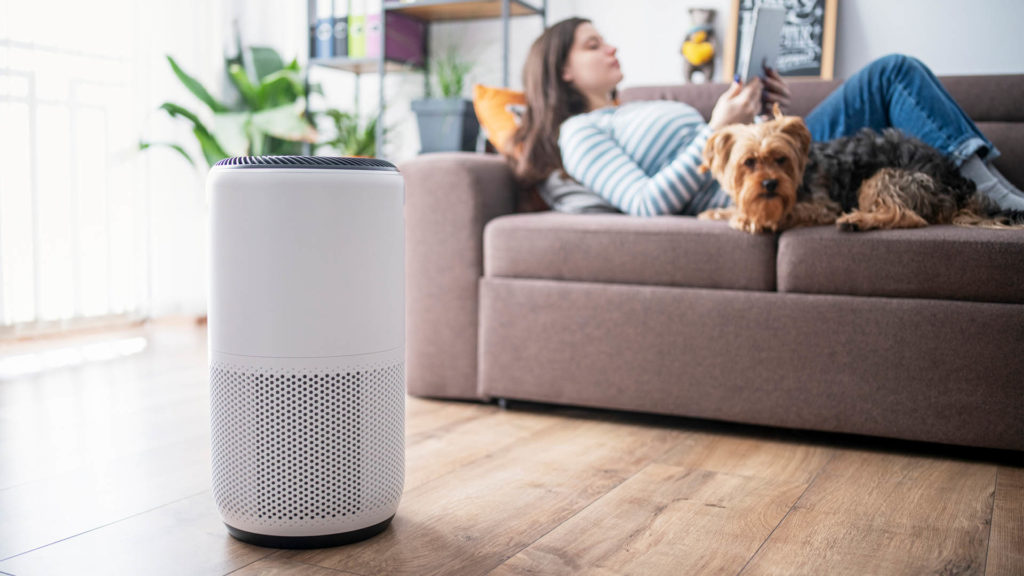
Some of the links on this page may link to our affiliates. Learn more about our ad policies.
How To Improve Indoor Air Quality

We consider our homes our safe space. It’s where we feel the most comfortable, the place we long for and the place we spend the majority of our time. But did you know the air you’re breathing inside your home may be bad for your health? It’s estimated that indoor air may be two to five times more polluted than the air outside – and breathing in all that bad air can lead to short-term and long-term health issues.
Find What You Need
What Causes Poor Indoor Air Quality?
Poor indoor air quality is the result of pollution caused by different types of contaminants accumulating inside your home. It can come from air fresheners, cigarettes, chemicals stored in the home, cleaning products, emissions from fireplaces, newer building materials, and stoves. Dust, pet dander, and pollen can also be contributors to bad air.
Fuel-burning stoves, heaters, and other appliances can emit carbon monoxide which can block the movement of oxygen in your body. Breathing in too much carbon monoxide can kill you. Natural gas and kerosene can send out nitrogen dioxide which can cause lung problems. Kerosene space heaters can emit sulfur dioxide, which irritates the eyes and upper respiratory tract.
Radon is naturally-occurring in the soil and can get inside your home through cracks in the drains, foundation, and walls. Radon is known to cause lung cancer. Tobacco smoke contains thousands of harmful chemicals that are known to pose health risks.
All of these contaminants can combine to contribute to poor air quality inside your home.
How Do I Check the Air Quality Inside My Home?
Every indoor environment is different, so there’s no one-size-fits-all test to measure all the aspects of your home’s air quality. Also, since there aren’t any federal limits on indoor contaminants, the Environmental Protection Agency (EPA) doesn’t recommend general testing for indoor air quality.
But if you continue to have recurring health problems and you’re concerned the air quality inside your home is the reason, there are things you can do to check it.
Keep a Daily Journal
This may take some work, but it will help you know what time of day you have symptoms or the rooms in your home where you may experience them. What changes have you made? New carpet? New detergent? New home improvements? Evaluating your home can help narrow down where you may have a problem.
Invest in an Air Quality Monitor
You can now buy air quality monitors for your home. Many of them can give you real-time feedback of what’s in your air and whether the levels are too high. Air quality monitors may not always tell you specifically what’s in your air, but it will let you know if it’s too polluted and not safe.
Check Carbon Monoxide and Radon Levels
You can’t smell carbon monoxide or radon, but both are very dangerous. Local home improvement stores sell detectors for both. Both are good to have whether you have regular air quality issues or not.
Test for Mold
Exposure to mold can have many symptoms that can look like allergies, but mold exposure is much more serious and have can have serious long-term impacts on your health. You can buy a do-it-yourself kit or have a professional come and test your home for mold.
Hire a Professional
You can find a reputable indoor air quality specialist by checking out organizations like the American Industrial Hygiene Association or the American Board of Industrial Hygiene. You can also ask your local real estate agents for recommendations.
What Problems Can Poor Indoor Air Quality Cause?
Years of research have shown that exposure to poor air quality can cause health problems. Unfortunately, it doesn’t take long to feel the effects of it. Sometimes, it can be immediate depending on your age and your pre-existing conditions. You may experience dizziness, fatigue, headaches, and irritation of the eyes, nose, and throat from short-term exposure. Since the symptoms are similar to colds and viruses, it can be hard to know if you’re getting sick or if it’s from breathing in polluted air. All you may need to do is get yourself away from the bad air for things to clear up. But if they don’t, you can usually treat yourself with over-the-counter medicines for problems caused by short-term exposure.
If you suffer from asthma or other respiratory issues, exposure to air pollution can aggravate or worsen your condition. Over time, continuous and long-term exposure to high levels of air pollution can lead to more severe issues. It can increase the risk of diabetes, kidney disease, low birth weight, and tuberculosis. It’s also been shown to cause chronic respiratory infections and diseases, heart disease and even lung cancer. Children and older people are more susceptible, as well as those who are already sick and people who live in highly polluted areas.
A report issued in 2019 by The Lancet Planetary Health showed that air pollution is responsible for about nine million premature deaths globally every year. A second study that same year, found that 53,000 premature deaths in the U.S. could be prevented every year if the country could eliminate all energy-related emissions.
How Can I Improve My Indoor Air Quality?
The good news is, while you may not be able to do much about outdoor air pollution by yourself, you can control the pollution inside your home.
Keep It Clean
Cleaning is no fun, but cleaning your home regularly can cut down on dust and pet dander that are floating around. Vacuum carpets and rugs at least once or twice a week. (Removing carpet and rugs altogether can also make a big difference.) Wash your bedding and drapes in hot water to get rid of allergens. Clean off the furniture where dust settles.
Get rid of clutter, because it tends to trap and hold dust. And put the plants outside because they can collect mold and help it to grow.
Change Your Filters
Your HVAC system works with a filter that traps some of the most common air pollutants. But those filters get dirty and need to be changed regularly, or they will stop doing their job. Changing them every three months is a good rule of thumb, but you should check them every month to see if you should change them more often. Keep an eye on other filters in your home, too and make sure they get changed or cleaned regularly. Your clothes dryer, kitchen vents, and vacuum cleaner filters should all be checked, cleaned, maintained, and replaced when needed.
Improve Ventilation Inside
These days, homes are made to be more energy-efficient. This means windows, doors, and foundations are more airtight. However, that also means when pollution gets inside, it has a hard time getting out. Opening windows and doors when the weather permits is a great way to get fresh air inside and let stale air out. It’s also worth checking the air ducts of your HVAC system to make sure there isn’t any build-up of pollutants or anything obstructing air flow.
Turn On the Vents
When you’re cooking, make sure you use the vent above the stove. Gas stoves can release carbon monoxide and nitrogen dioxide. Electric stovetops can also produce pollutants. Using the vent can filter those things out of the air.
Invest in an Air Purifier
An air purifier is one of the best ways to improve air quality inside your home. They trap the smallest of particles and pollutants, and send cleaner, purified air back out. Finding the right air purifier for your needs depends on several factors, including understanding your issue (allergies, asthma, etc), room size, nose level, and more.
Control the Humidity
Humid or damp conditions are perfect for mildew and mold, which can cause severe health issues. Dehumidifiers can cut down on the moisture inside your home. It’s also important to regularly check for leaks around your pipes, roofs and foundations and fix them.
Summary
Combating air pollution can seem like an overwhelming job, but there are small, manageable things you can do inside your home to control what you’re breathing. Any step you take to cleaner, purer air is a healthy step for you and your family.



